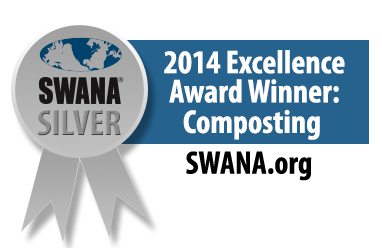Environmental Management System
Since 2011, the Montgomery County Yard Trim Composting Facility (MCYTCF) operations have been conducted under an Environmental Management System (EMS) developed by County Staff and the Maryland Environmental Service (MES). The EMS provides a process-oriented approach to environmental management that goes beyond regulatory compliance, focused on continuous improvement of the environmental performance of the MCYTCF operations.
Awards and Recognitions

In 2013, the Facility’s EMS was certified by American System Registrar, an external auditing company, as in full conformance with the
ISO 14001:2004 Standard.
Read our article about the certification process in the January 2014 issue of Biocycle magazine.
In June 2014, the Solid Waste Association of North America (SWANA) awarded MCYTCF with its Silver Excellence Award in the Composting category. The EMS was the core element in this recognition. Later that year, the facility also received a National Association of Counties Achievement Award recognizing innovative county government programs such as the Environmental Management System in the category of a publicly owned composting facility.
In July 2016, the MCYTCY became the first composting facility in the United States to satisfy the ISO 14001 Standard released in late 2015. In October 2016 the MCYTCF was recognized through Montgomery County’s Green Business Certification Program.
Significant Environmental Impacts and Aspects under the EMS
The ISO 14001 standard requires the identification of the Facility's "Significant Environmental Aspects (SEA) and Impacts (SEI)" of the composting process and all the ancillary operations within the scope of the EMS.
In ISO parlance
- an environmental "aspect" is "an element of an organization’s activities, products or services that can interact with the environment"
- an "impact" is "any change in the environment, whether adverse or beneficial, wholly or partially resulting from an aspect"
Staff of the Composting Facility, with the input from the host community group called the Dickerson Area Facilities Implementation Group (DAFIG) , developed the list of SEA and related SEI. This list is review and update regularly, the table below shows the current environmental aspects and impacts as well as the target of the environmental programs the staff at the MCYTCF is working on.
| Process | Environmental Aspect (Activity) | Potential Impact | Objective | Target |
|---|---|---|---|---|
| Materials Processing | 1) Decomposition of yard trim in windrows 2) Delayed delivery of truck transport and 3) Vendor deliveries | Potential for fire hazard and potential material ignition | Reduce the risk of fire | No fire incidents in a calendar year |
| Stormwater Control | Stormwater discharges | Water quality degradation | Compliance with all NPDES permits | Achieve 100% compliance with the NPDES permit discharge limits |
| Field Onsite Operations | Composting equipment powered by fossil fuel | Air pollution & GHG effects | Reduce air pollution Improve fuel efficiency | Reduce fossil fuel consumption by 5% |
| Field onsite operations | Purchase of operational supplies | Use of natural resources and GHG effects | Reduce indirect air pollution and GHG effects | Minimum of 50% of Bagging Supplies expenses spent on Recycled/Rebuilt, Pallets, Slip Sheets, Biogenic Polyethylene Bags, Pallet Shrouds, Stretch Film |
| Lighting | Use of electricity | Air pollution; GHG effects | Reduce air pollution and GHG effects through reduced use of electricity | Reduce GHG emissions (electricity weather normalized) |
The Environmental Team, composed of Recycling and Resource Management Division employees and MES field staff, has spent the last six years working to reach several milestones such as the independent certifications of the EMS: first with the ISO 14001:2004 Standard and then with the 2015 standard. The County's composting operation is carried out under the most rigorous environmental standard beyond legal environmental compliance.
The EMS has demonstrated continuous improvement in the areas of environmental performance, regulatory compliance, and pollution prevention. Currently, the MCYTCF’s Environmental Team is working on five Environmental Management Programs (EMPs), ranging from reducing the risk of oil spills to reducing greenhouse gases (GHG). During the fiscal year 2017, the Environmental Team succeeded in the traffic and air pollution EMP, reducing the number of trips needed to transport Leafgro.
In 2018 the carbon footprint was reduced significantly switching the packaging for Leafgro®, from nonrenewable (conventional oil-based polyethylene) packing to a sustainable resource made from sugarcane. Cultivation of sugarcane utilizes carbon dioxide (CO2) and releases oxygen (O2), which means the resin used to make the bioplastic has a negative carbon footprint. Read the Press Release.
Conclusion about total GHG Emissions produce by electricity consumption (Pavilion and Scale House) and fossil fuel (Equipment), weather normalized.
Using the EPA Portfolio Manager to track the GHG emissions, shows that the facility in 2020 decreased its overall emissions by 13 percent, 15 and 6 percent less emissions due to fossil fuel consumption and electricity consumption respectively.